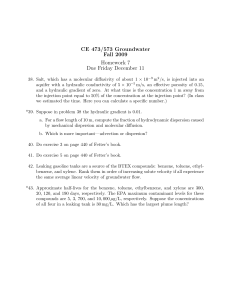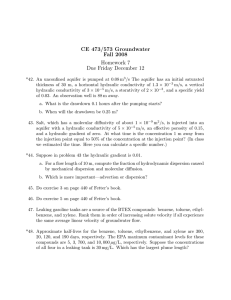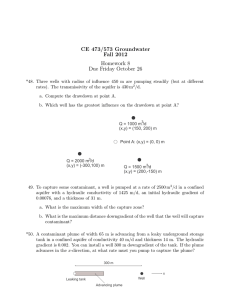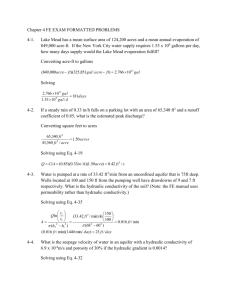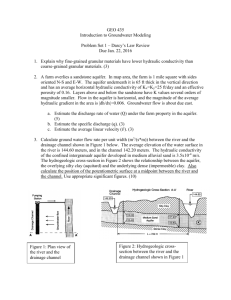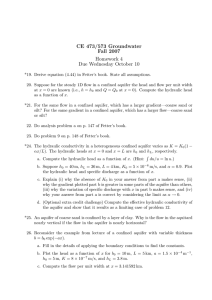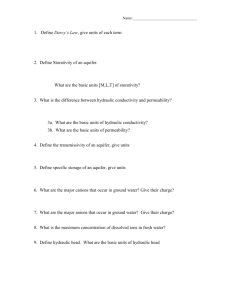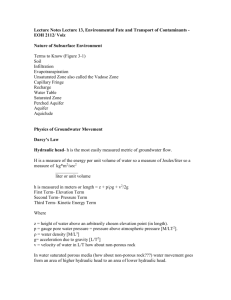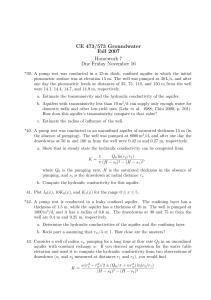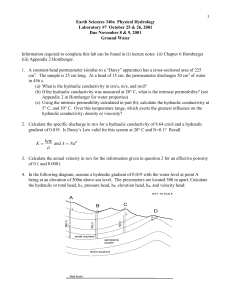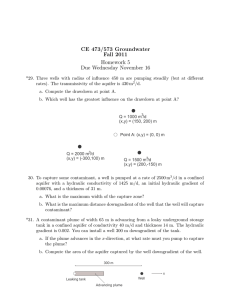CE 473/573 Groundwater Fall 2007 Homework 8 Approximately optional
advertisement
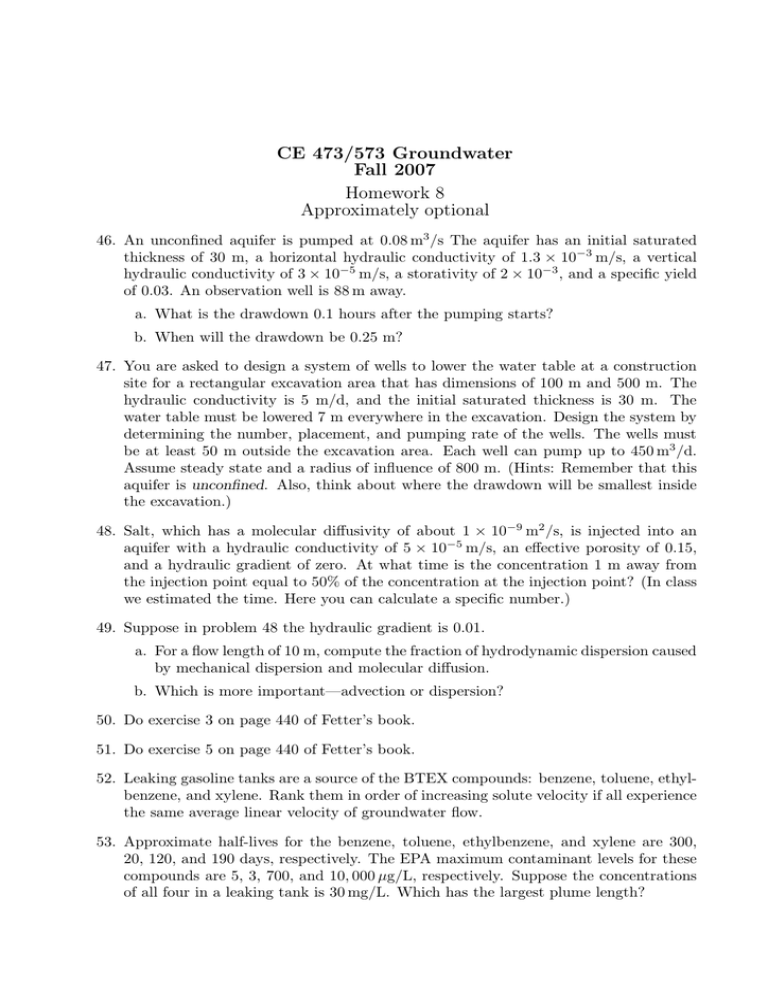
CE 473/573 Groundwater Fall 2007 Homework 8 Approximately optional 46. An unconfined aquifer is pumped at 0.08 m3 /s The aquifer has an initial saturated thickness of 30 m, a horizontal hydraulic conductivity of 1.3 × 10−3 m/s, a vertical hydraulic conductivity of 3 × 10−5 m/s, a storativity of 2 × 10−3 , and a specific yield of 0.03. An observation well is 88 m away. a. What is the drawdown 0.1 hours after the pumping starts? b. When will the drawdown be 0.25 m? 47. You are asked to design a system of wells to lower the water table at a construction site for a rectangular excavation area that has dimensions of 100 m and 500 m. The hydraulic conductivity is 5 m/d, and the initial saturated thickness is 30 m. The water table must be lowered 7 m everywhere in the excavation. Design the system by determining the number, placement, and pumping rate of the wells. The wells must be at least 50 m outside the excavation area. Each well can pump up to 450 m3 /d. Assume steady state and a radius of influence of 800 m. (Hints: Remember that this aquifer is unconfined. Also, think about where the drawdown will be smallest inside the excavation.) 48. Salt, which has a molecular diffusivity of about 1 × 10−9 m2 /s, is injected into an aquifer with a hydraulic conductivity of 5 × 10−5 m/s, an effective porosity of 0.15, and a hydraulic gradient of zero. At what time is the concentration 1 m away from the injection point equal to 50% of the concentration at the injection point? (In class we estimated the time. Here you can calculate a specific number.) 49. Suppose in problem 48 the hydraulic gradient is 0.01. a. For a flow length of 10 m, compute the fraction of hydrodynamic dispersion caused by mechanical dispersion and molecular diffusion. b. Which is more important—advection or dispersion? 50. Do exercise 3 on page 440 of Fetter’s book. 51. Do exercise 5 on page 440 of Fetter’s book. 52. Leaking gasoline tanks are a source of the BTEX compounds: benzene, toluene, ethylbenzene, and xylene. Rank them in order of increasing solute velocity if all experience the same average linear velocity of groundwater flow. 53. Approximate half-lives for the benzene, toluene, ethylbenzene, and xylene are 300, 20, 120, and 190 days, respectively. The EPA maximum contaminant levels for these compounds are 5, 3, 700, and 10, 000 µg/L, respectively. Suppose the concentrations of all four in a leaking tank is 30 mg/L. Which has the largest plume length? 54. (Old exam problem) A manufacturing plant has been leaking 1,1-dichloroethane into a confined aquifer of thickness 13 m since the 1960s. The aquifer has hydraulic conductivity 5 m/d, effective porosity 21%, soil organic carbon content 0.4%, bulk density 2.4 g/cm3 , and hydraulic gradient with a magnitude of 0.01. Studies nearby show the dispersivity to be about 5 m. The contaminant 1,1-dichloroethane has a solubility of 5500 ppm, a half-life of about 110 days, a value of Koc of 45 mL/g, and a maximum contaminant level (MCL) of 7 µg/L. a. If the concentration of 1,1-dichloroethane at the source of the leak is 25 mg/L, how long is the plume—that is, how far downgradient is the concentration above the MCL? b. A well is to be installed so that the contaminated water can be pumped and treated. However, it cannot be placed downgradient of the source because of a parking lot. If it is placed 50 m upgradient of the source, what flowrate would you recommend using? c. Would the required flowrate from part b increase or decrease if the following parameters increase? Briefly explain why. i. ii. iii. iv. v. Half-life Soil-water partition coefficient Koc Hydraulic gradient Aquifer thickness Source concentration Groundwater flow Parking lot Proposed well Leak source 50 m Building
